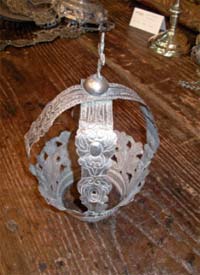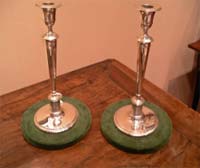|
1. The guilds
The guilds guaranteed the professional training of their members as well as supervising it. They also demanded that each artisan proved his artistic abilities. At the same time, the guilds provided help to widows and orphans of silversmiths.
In the Middle Ages, existed many different types of artisan guilds such as the royal or the council guild. However, different rules start appearing in each city that guilds existed with their own peculiarities and characteristics, which sets them apart from the rest. These norms were meant to regulate craftsmen abilities, the specific types of work corresponding to each trade, the fees and taxes, the licences to open shops. The 16 th century Malaga norms, for instance, make no special reference to silversmiths. Furthermore, there is only one specification regarding coal: "When silversmiths, ironsmiths or locksmiths don't have enough coal, ironsmiths who have adequate provisions of coal, should give them a third of what they have, at wholesale price". A regulation of 1555 forbids the practice of their trade to those artisans who had not paid their fee. In 1560, the city of Malaga already had a mayor of silversmiths.
The master silversmith
 During the 15th century, silver artisans were much respected by the population due to the belief that silver and gold craftsmanship was one of the noble and high arts. At the time, in line with fashion, there was a genealogy of notable silversmiths, which originated from the Old Testament. In 1555, Charles I granted silver and gold craftsmen and their wives the use of silk clothing, which was forbidden to members of other trades. At the same time, the monarch ordered they be called artisans and not tradesmen, since they were seen as practicing a "liberal art". In 1619, Philip III renewed their right to run for public offices, such as mayor, general procurator, official or deputy, and were allowed to obtain nobility rank and not pay taxes for the exercise of their art. In 1636, in spite of the country's involvement in wars, Philip IV excluded them from the obligation to provide accommodation to soldiers or to pay a contribution for the troops, as the rest of the tradesmen were obliged to do. During the 15th century, silver artisans were much respected by the population due to the belief that silver and gold craftsmanship was one of the noble and high arts. At the time, in line with fashion, there was a genealogy of notable silversmiths, which originated from the Old Testament. In 1555, Charles I granted silver and gold craftsmen and their wives the use of silk clothing, which was forbidden to members of other trades. At the same time, the monarch ordered they be called artisans and not tradesmen, since they were seen as practicing a "liberal art". In 1619, Philip III renewed their right to run for public offices, such as mayor, general procurator, official or deputy, and were allowed to obtain nobility rank and not pay taxes for the exercise of their art. In 1636, in spite of the country's involvement in wars, Philip IV excluded them from the obligation to provide accommodation to soldiers or to pay a contribution for the troops, as the rest of the tradesmen were obliged to do.
Silversmiths, originally, had certain characteristics of religious institutions. They were taken under the wings of the Patron's chapel, and as time went by and they grew in numbers, the institution evolved into a complex professional organisation which always maintained a religious spirit.
The master silversmith, who was qualified in his trade, and in possession of a corresponding examination diploma, was allowed to set up his own workshop, sometimes annexed to the back room of a silver craft shop. The shop and the workshop often functioned in complete independence from one another. In general, each master silversmith was a specialist in a particular type of work. When a work was commissioned which required work from several specialists, the master silversmith who had received the commission was responsible for commissioning the rest of the different specialists needed. There was a great sense of camaraderie among them; they would sometimes lend each other material and tools for the exercise of their art.
The trade could not be carried out at home and citizens were not allowed to have furnaces at home. Furthermore, a silversmith could not use low quality silver, even if asked to do so by a private client. The master silversmith was frequently called upon to perform valuations of jewellery in legal disputes and inheritances. From the mid 17 th century there was the position of the Master Silversmith of the Holy Church Cathedral, who was responsible for the adornment, silver-plating and polishing of the pieces belonging to the temple.
There was also the master Stonesmith, the specialist in carving and mounting stones, independent of the art of the silver craft. The master Stonesmith was also the jeweller. According to Cellini, there were five types of precious stones: rubies, emeralds, diamonds, sapphires and topaz. It wasn't until the end of the 18 th century that they got hold of fake stones from chemical procedures. Fakes were created with dyes and the true experts were in Milan.
Examinations
In order to be in possession of a shop, workshop or the title of the master, it was necessary to pass an examination and to pay the rights to practice the art. The stipend could vary according to the economic status of the aspiring candidate. The Elder Father, the silver guardian and the gold guardian constituted the examination tribunal. The procedure was the following: 1) The request was read, 2) Lots were drawn to select a drawing sheet from the drawing books, 3) The candidate drew it in the presence of the tribunal, and 4) The candidate had to build the piece within the agreed period of time at the workshop of one of the guardians, 5) If the result was not satisfactory, the candidate could repeat the work, until the result was, according to the tribunal, satisfactory.
Shops
All complaints were heard at the chapter and the shop and workshop licences were granted. Norms were established with the best practices for crafting the pieces. At the chapter, the taxes on sale prices and the wages of the workers were also established. The shops had to be centrally located. In general, each shop had its workshop. In order to obtain a shop permit, besides the examination, it was necessary to pay the Council and the confraternity fee. Blacks, slaves and new Christians were not allowed to have shops. No one was allowed to have more than one shop. Decent widows could keep the shop, selling only the works of approved masters. They did not lose the right to run the shop if they remarried, provided they married a craftsman of the trade, in possession of the examination title. From 1790, widows could marry anyone they wished for without losing the right to keep the shop.
Workshop
Silver craft workshop furnishings were generally made up of a large bench with drawers, a small bench for delicate works, a side bench, a footstool, chairs, stools, arc, large scales for up to four pounds, and small scales. The tools were a large seed-pearl cutter, a flattening frame, a device for working long and fine pieces, an octagonal anvil, set of compasses and scissors, some twenty different hammers with lathe ends to groove, hammer and flatten, with two mouths to forge; wooden and iron chisels, graters, lead moulds, forge, pumps, hundreds of crucibles, pitch bowl, sharpening stones, pumice stone, files, tweezers for forging and emptying; threaders for round or square threads, lathe with mould box, steel with iron pipes, spoon stake, large plate pin, etc.
Commissions / contracts
 The commissioning was done by means of true contracts. The craftsman appeared before one of the scribes of the city, accompanied by a trusted person. The commissioner either represented himself or a civil or religious community. Unfortunately for the history, no detailed description of the commissioned work or of the technique used has ever been recorded. Together with the contract came a wax model where everything was clearly instructed. However, they did specify that the work had to be perfect and to the full satisfaction of the commissioning party. Sometimes, in important commissions, the expert services of other master silversmiths were allowed to be used. The commissioning was done by means of true contracts. The craftsman appeared before one of the scribes of the city, accompanied by a trusted person. The commissioner either represented himself or a civil or religious community. Unfortunately for the history, no detailed description of the commissioned work or of the technique used has ever been recorded. Together with the contract came a wax model where everything was clearly instructed. However, they did specify that the work had to be perfect and to the full satisfaction of the commissioning party. Sometimes, in important commissions, the expert services of other master silversmiths were allowed to be used.
|
